NUR231 Case Study: Managing Sciatica and Hyperemesis in Pregnancy
VerifiedAdded on 2023/04/04
|12
|3080
|390
Case Study
AI Summary
This case study presents the case of Kelly, an 18-week pregnant woman suffering from sciatica and hyperemesis, complicated by a history of severe viral hepatitis leading to permanent liver dysfunction. The analysis explores the potential causes of increased sciatica during pregnancy, such as weight gain, postural imbalances, and uterine expansion. It investigates the impact of Kelly's liver failure on the effectiveness of medications like metoclopramide and paracetamol, highlighting the role of hepatic first-pass metabolism. The study considers alternative drug administration methods, such as intravenous delivery, to bypass liver metabolism and enhance drug efficacy. It also compares the effectiveness of metoclopramide and ondansetron in managing hyperemesis, suggesting a combination therapy for optimal results. Furthermore, the study discusses the relationship between gastrointestinal issues, nausea, and vomiting during pregnancy, including the potential role of gastroenteritis and food aversions. Finally, it addresses the use of pethidine for pain relief during labor and its associated complications, such as increased nausea and vomiting. The case study emphasizes the importance of tailored treatment strategies and dietary modifications to improve Kelly's overall well-being during pregnancy.

Bachelor of nursing 1
Bachelor of Nursing
Name
Institution
Bachelor of Nursing
Name
Institution
Paraphrase This Document
Need a fresh take? Get an instant paraphrase of this document with our AI Paraphraser
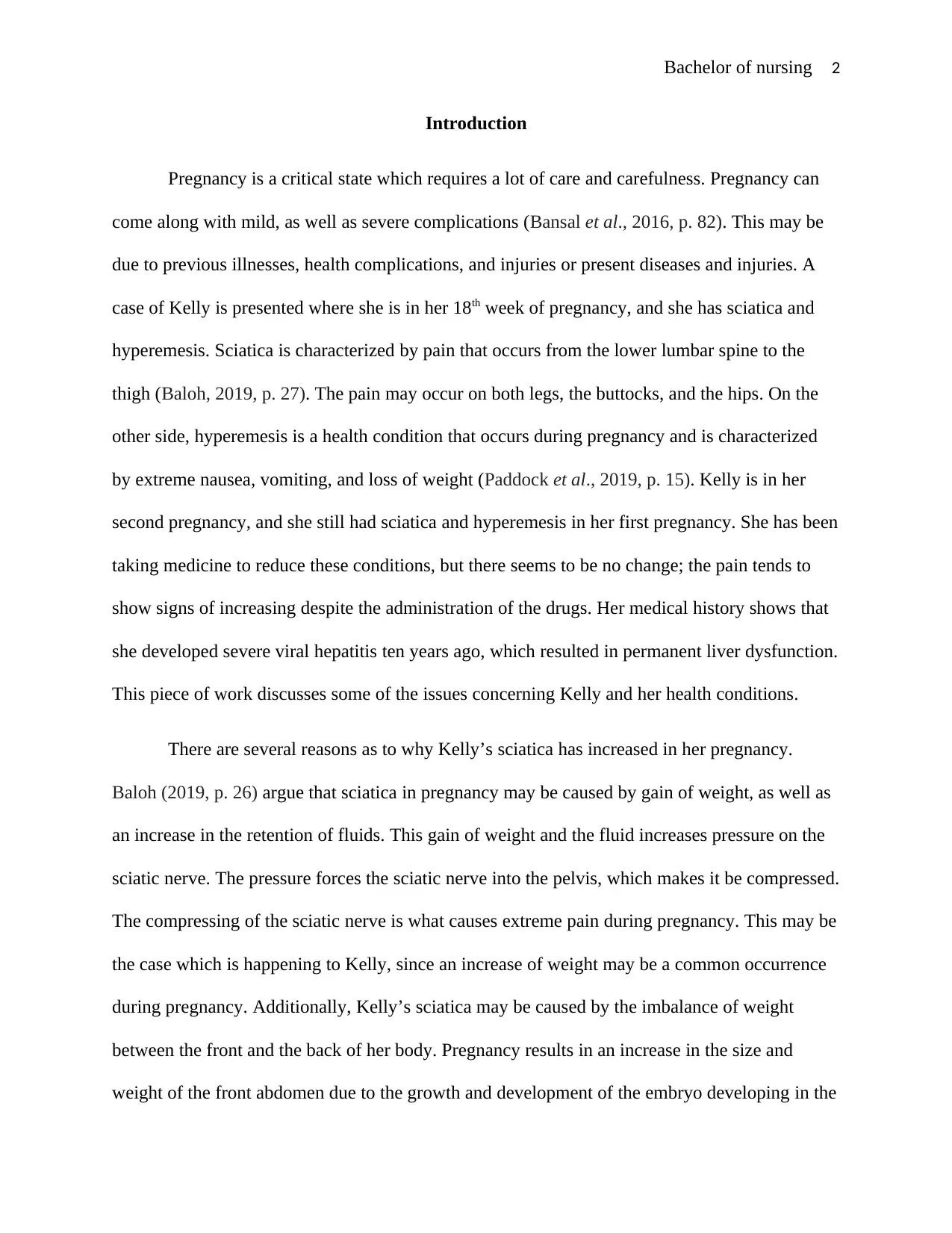
Bachelor of nursing 2
Introduction
Pregnancy is a critical state which requires a lot of care and carefulness. Pregnancy can
come along with mild, as well as severe complications (Bansal et al., 2016, p. 82). This may be
due to previous illnesses, health complications, and injuries or present diseases and injuries. A
case of Kelly is presented where she is in her 18th week of pregnancy, and she has sciatica and
hyperemesis. Sciatica is characterized by pain that occurs from the lower lumbar spine to the
thigh (Baloh, 2019, p. 27). The pain may occur on both legs, the buttocks, and the hips. On the
other side, hyperemesis is a health condition that occurs during pregnancy and is characterized
by extreme nausea, vomiting, and loss of weight (Paddock et al., 2019, p. 15). Kelly is in her
second pregnancy, and she still had sciatica and hyperemesis in her first pregnancy. She has been
taking medicine to reduce these conditions, but there seems to be no change; the pain tends to
show signs of increasing despite the administration of the drugs. Her medical history shows that
she developed severe viral hepatitis ten years ago, which resulted in permanent liver dysfunction.
This piece of work discusses some of the issues concerning Kelly and her health conditions.
There are several reasons as to why Kelly’s sciatica has increased in her pregnancy.
Baloh (2019, p. 26) argue that sciatica in pregnancy may be caused by gain of weight, as well as
an increase in the retention of fluids. This gain of weight and the fluid increases pressure on the
sciatic nerve. The pressure forces the sciatic nerve into the pelvis, which makes it be compressed.
The compressing of the sciatic nerve is what causes extreme pain during pregnancy. This may be
the case which is happening to Kelly, since an increase of weight may be a common occurrence
during pregnancy. Additionally, Kelly’s sciatica may be caused by the imbalance of weight
between the front and the back of her body. Pregnancy results in an increase in the size and
weight of the front abdomen due to the growth and development of the embryo developing in the
Introduction
Pregnancy is a critical state which requires a lot of care and carefulness. Pregnancy can
come along with mild, as well as severe complications (Bansal et al., 2016, p. 82). This may be
due to previous illnesses, health complications, and injuries or present diseases and injuries. A
case of Kelly is presented where she is in her 18th week of pregnancy, and she has sciatica and
hyperemesis. Sciatica is characterized by pain that occurs from the lower lumbar spine to the
thigh (Baloh, 2019, p. 27). The pain may occur on both legs, the buttocks, and the hips. On the
other side, hyperemesis is a health condition that occurs during pregnancy and is characterized
by extreme nausea, vomiting, and loss of weight (Paddock et al., 2019, p. 15). Kelly is in her
second pregnancy, and she still had sciatica and hyperemesis in her first pregnancy. She has been
taking medicine to reduce these conditions, but there seems to be no change; the pain tends to
show signs of increasing despite the administration of the drugs. Her medical history shows that
she developed severe viral hepatitis ten years ago, which resulted in permanent liver dysfunction.
This piece of work discusses some of the issues concerning Kelly and her health conditions.
There are several reasons as to why Kelly’s sciatica has increased in her pregnancy.
Baloh (2019, p. 26) argue that sciatica in pregnancy may be caused by gain of weight, as well as
an increase in the retention of fluids. This gain of weight and the fluid increases pressure on the
sciatic nerve. The pressure forces the sciatic nerve into the pelvis, which makes it be compressed.
The compressing of the sciatic nerve is what causes extreme pain during pregnancy. This may be
the case which is happening to Kelly, since an increase of weight may be a common occurrence
during pregnancy. Additionally, Kelly’s sciatica may be caused by the imbalance of weight
between the front and the back of her body. Pregnancy results in an increase in the size and
weight of the front abdomen due to the growth and development of the embryo developing in the
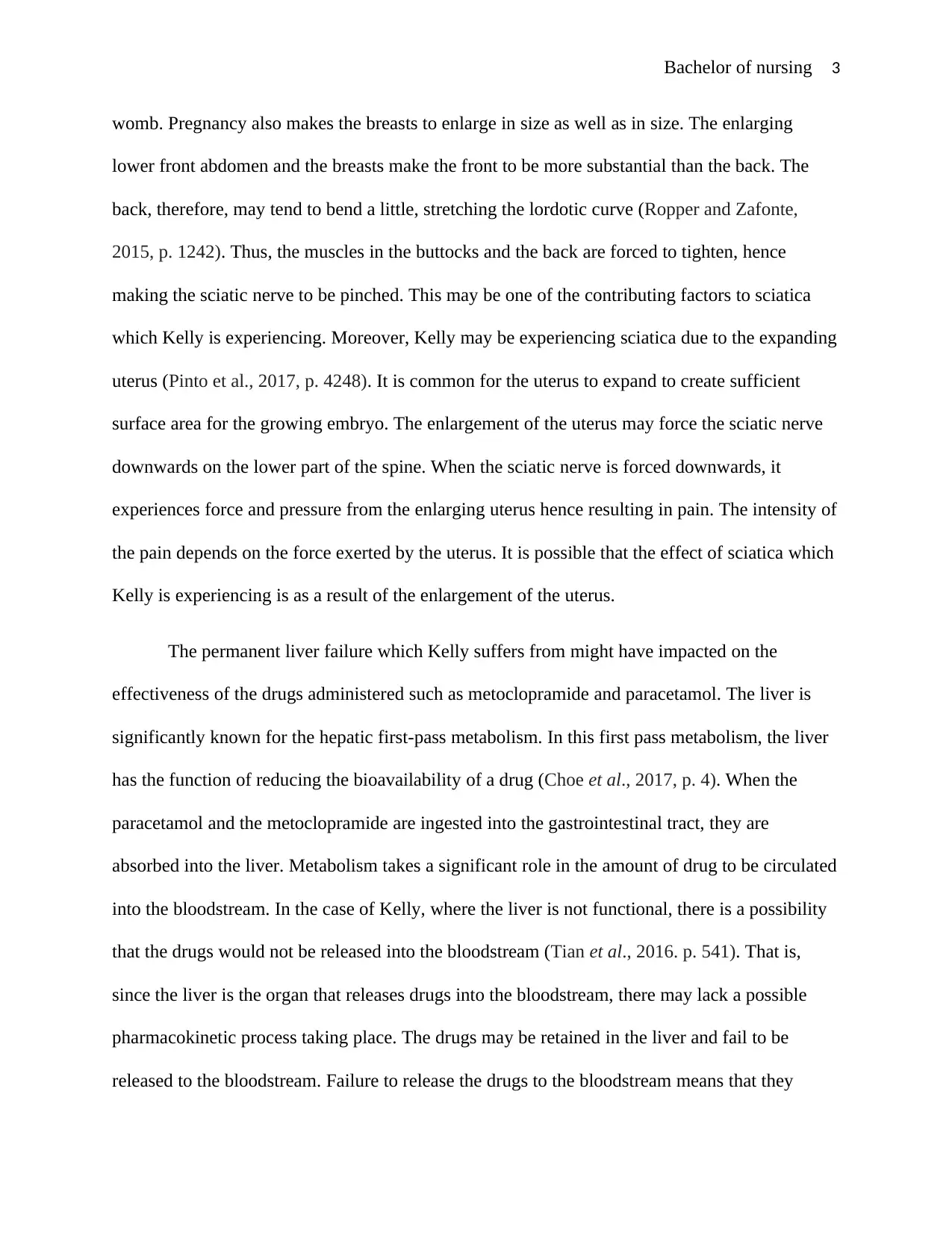
Bachelor of nursing 3
womb. Pregnancy also makes the breasts to enlarge in size as well as in size. The enlarging
lower front abdomen and the breasts make the front to be more substantial than the back. The
back, therefore, may tend to bend a little, stretching the lordotic curve (Ropper and Zafonte,
2015, p. 1242). Thus, the muscles in the buttocks and the back are forced to tighten, hence
making the sciatic nerve to be pinched. This may be one of the contributing factors to sciatica
which Kelly is experiencing. Moreover, Kelly may be experiencing sciatica due to the expanding
uterus (Pinto et al., 2017, p. 4248). It is common for the uterus to expand to create sufficient
surface area for the growing embryo. The enlargement of the uterus may force the sciatic nerve
downwards on the lower part of the spine. When the sciatic nerve is forced downwards, it
experiences force and pressure from the enlarging uterus hence resulting in pain. The intensity of
the pain depends on the force exerted by the uterus. It is possible that the effect of sciatica which
Kelly is experiencing is as a result of the enlargement of the uterus.
The permanent liver failure which Kelly suffers from might have impacted on the
effectiveness of the drugs administered such as metoclopramide and paracetamol. The liver is
significantly known for the hepatic first-pass metabolism. In this first pass metabolism, the liver
has the function of reducing the bioavailability of a drug (Choe et al., 2017, p. 4). When the
paracetamol and the metoclopramide are ingested into the gastrointestinal tract, they are
absorbed into the liver. Metabolism takes a significant role in the amount of drug to be circulated
into the bloodstream. In the case of Kelly, where the liver is not functional, there is a possibility
that the drugs would not be released into the bloodstream (Tian et al., 2016. p. 541). That is,
since the liver is the organ that releases drugs into the bloodstream, there may lack a possible
pharmacokinetic process taking place. The drugs may be retained in the liver and fail to be
released to the bloodstream. Failure to release the drugs to the bloodstream means that they
womb. Pregnancy also makes the breasts to enlarge in size as well as in size. The enlarging
lower front abdomen and the breasts make the front to be more substantial than the back. The
back, therefore, may tend to bend a little, stretching the lordotic curve (Ropper and Zafonte,
2015, p. 1242). Thus, the muscles in the buttocks and the back are forced to tighten, hence
making the sciatic nerve to be pinched. This may be one of the contributing factors to sciatica
which Kelly is experiencing. Moreover, Kelly may be experiencing sciatica due to the expanding
uterus (Pinto et al., 2017, p. 4248). It is common for the uterus to expand to create sufficient
surface area for the growing embryo. The enlargement of the uterus may force the sciatic nerve
downwards on the lower part of the spine. When the sciatic nerve is forced downwards, it
experiences force and pressure from the enlarging uterus hence resulting in pain. The intensity of
the pain depends on the force exerted by the uterus. It is possible that the effect of sciatica which
Kelly is experiencing is as a result of the enlargement of the uterus.
The permanent liver failure which Kelly suffers from might have impacted on the
effectiveness of the drugs administered such as metoclopramide and paracetamol. The liver is
significantly known for the hepatic first-pass metabolism. In this first pass metabolism, the liver
has the function of reducing the bioavailability of a drug (Choe et al., 2017, p. 4). When the
paracetamol and the metoclopramide are ingested into the gastrointestinal tract, they are
absorbed into the liver. Metabolism takes a significant role in the amount of drug to be circulated
into the bloodstream. In the case of Kelly, where the liver is not functional, there is a possibility
that the drugs would not be released into the bloodstream (Tian et al., 2016. p. 541). That is,
since the liver is the organ that releases drugs into the bloodstream, there may lack a possible
pharmacokinetic process taking place. The drugs may be retained in the liver and fail to be
released to the bloodstream. Failure to release the drugs to the bloodstream means that they
⊘ This is a preview!⊘
Do you want full access?
Subscribe today to unlock all pages.

Trusted by 1+ million students worldwide
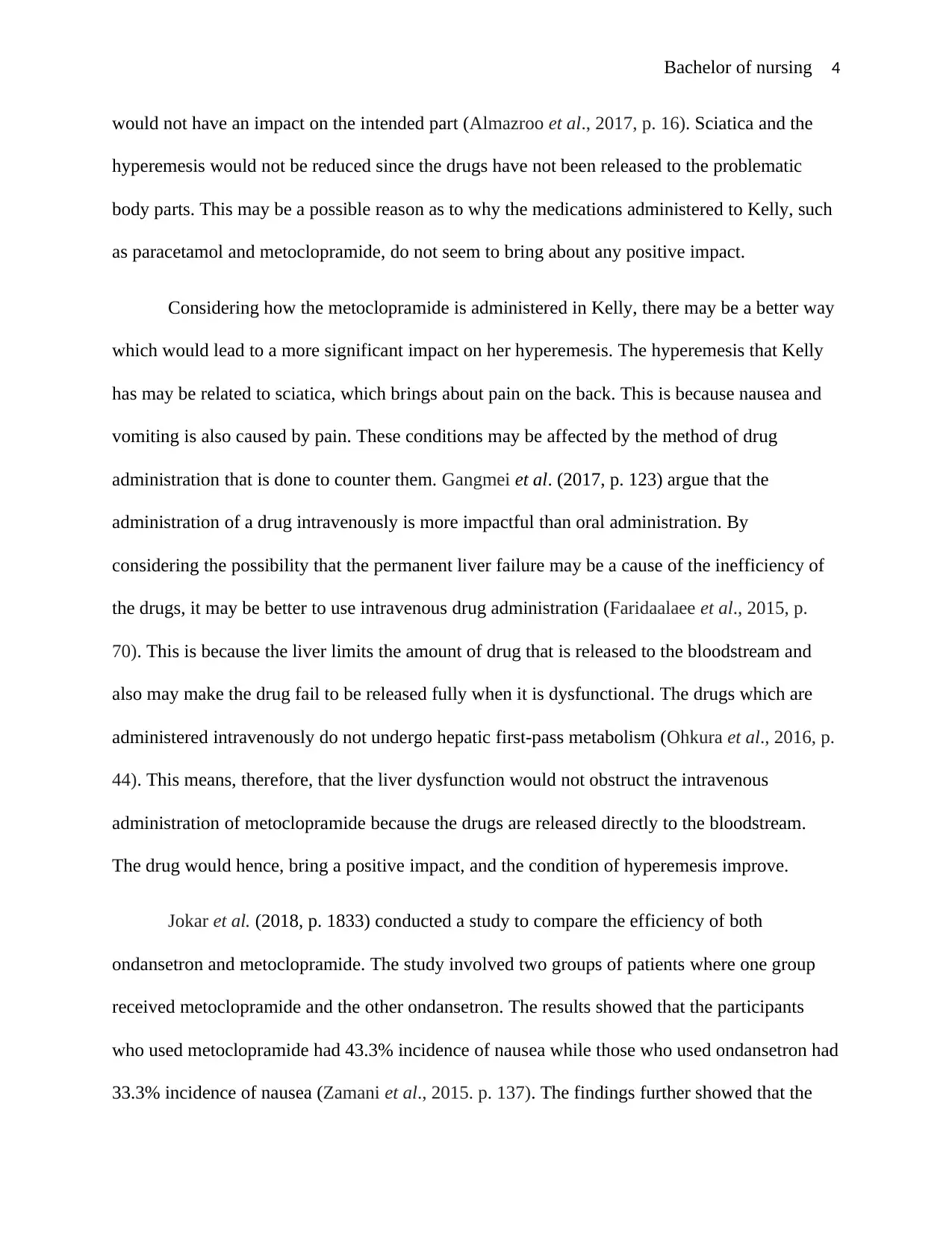
Bachelor of nursing 4
would not have an impact on the intended part (Almazroo et al., 2017, p. 16). Sciatica and the
hyperemesis would not be reduced since the drugs have not been released to the problematic
body parts. This may be a possible reason as to why the medications administered to Kelly, such
as paracetamol and metoclopramide, do not seem to bring about any positive impact.
Considering how the metoclopramide is administered in Kelly, there may be a better way
which would lead to a more significant impact on her hyperemesis. The hyperemesis that Kelly
has may be related to sciatica, which brings about pain on the back. This is because nausea and
vomiting is also caused by pain. These conditions may be affected by the method of drug
administration that is done to counter them. Gangmei et al. (2017, p. 123) argue that the
administration of a drug intravenously is more impactful than oral administration. By
considering the possibility that the permanent liver failure may be a cause of the inefficiency of
the drugs, it may be better to use intravenous drug administration (Faridaalaee et al., 2015, p.
70). This is because the liver limits the amount of drug that is released to the bloodstream and
also may make the drug fail to be released fully when it is dysfunctional. The drugs which are
administered intravenously do not undergo hepatic first-pass metabolism (Ohkura et al., 2016, p.
44). This means, therefore, that the liver dysfunction would not obstruct the intravenous
administration of metoclopramide because the drugs are released directly to the bloodstream.
The drug would hence, bring a positive impact, and the condition of hyperemesis improve.
Jokar et al. (2018, p. 1833) conducted a study to compare the efficiency of both
ondansetron and metoclopramide. The study involved two groups of patients where one group
received metoclopramide and the other ondansetron. The results showed that the participants
who used metoclopramide had 43.3% incidence of nausea while those who used ondansetron had
33.3% incidence of nausea (Zamani et al., 2015. p. 137). The findings further showed that the
would not have an impact on the intended part (Almazroo et al., 2017, p. 16). Sciatica and the
hyperemesis would not be reduced since the drugs have not been released to the problematic
body parts. This may be a possible reason as to why the medications administered to Kelly, such
as paracetamol and metoclopramide, do not seem to bring about any positive impact.
Considering how the metoclopramide is administered in Kelly, there may be a better way
which would lead to a more significant impact on her hyperemesis. The hyperemesis that Kelly
has may be related to sciatica, which brings about pain on the back. This is because nausea and
vomiting is also caused by pain. These conditions may be affected by the method of drug
administration that is done to counter them. Gangmei et al. (2017, p. 123) argue that the
administration of a drug intravenously is more impactful than oral administration. By
considering the possibility that the permanent liver failure may be a cause of the inefficiency of
the drugs, it may be better to use intravenous drug administration (Faridaalaee et al., 2015, p.
70). This is because the liver limits the amount of drug that is released to the bloodstream and
also may make the drug fail to be released fully when it is dysfunctional. The drugs which are
administered intravenously do not undergo hepatic first-pass metabolism (Ohkura et al., 2016, p.
44). This means, therefore, that the liver dysfunction would not obstruct the intravenous
administration of metoclopramide because the drugs are released directly to the bloodstream.
The drug would hence, bring a positive impact, and the condition of hyperemesis improve.
Jokar et al. (2018, p. 1833) conducted a study to compare the efficiency of both
ondansetron and metoclopramide. The study involved two groups of patients where one group
received metoclopramide and the other ondansetron. The results showed that the participants
who used metoclopramide had 43.3% incidence of nausea while those who used ondansetron had
33.3% incidence of nausea (Zamani et al., 2015. p. 137). The findings further showed that the
Paraphrase This Document
Need a fresh take? Get an instant paraphrase of this document with our AI Paraphraser
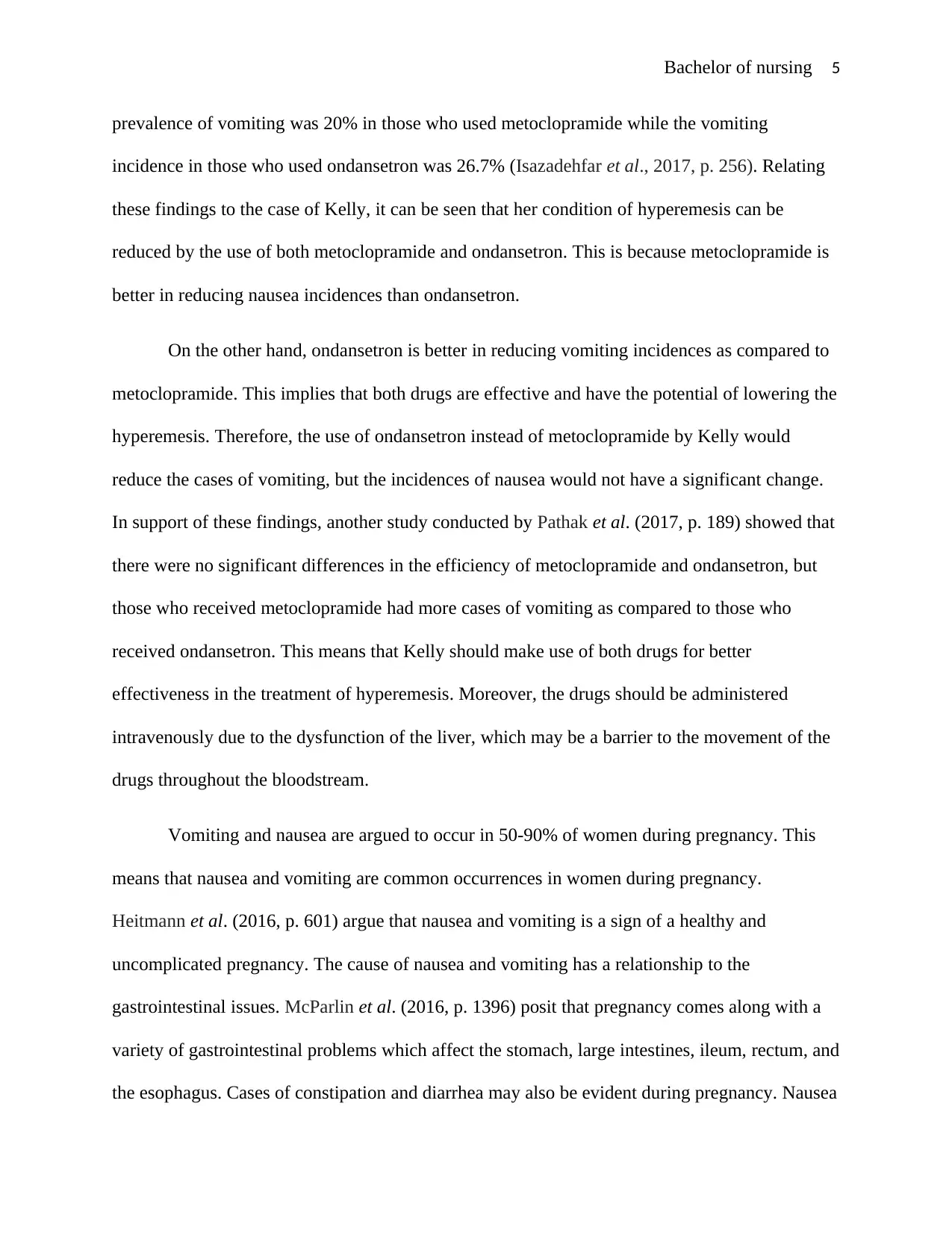
Bachelor of nursing 5
prevalence of vomiting was 20% in those who used metoclopramide while the vomiting
incidence in those who used ondansetron was 26.7% (Isazadehfar et al., 2017, p. 256). Relating
these findings to the case of Kelly, it can be seen that her condition of hyperemesis can be
reduced by the use of both metoclopramide and ondansetron. This is because metoclopramide is
better in reducing nausea incidences than ondansetron.
On the other hand, ondansetron is better in reducing vomiting incidences as compared to
metoclopramide. This implies that both drugs are effective and have the potential of lowering the
hyperemesis. Therefore, the use of ondansetron instead of metoclopramide by Kelly would
reduce the cases of vomiting, but the incidences of nausea would not have a significant change.
In support of these findings, another study conducted by Pathak et al. (2017, p. 189) showed that
there were no significant differences in the efficiency of metoclopramide and ondansetron, but
those who received metoclopramide had more cases of vomiting as compared to those who
received ondansetron. This means that Kelly should make use of both drugs for better
effectiveness in the treatment of hyperemesis. Moreover, the drugs should be administered
intravenously due to the dysfunction of the liver, which may be a barrier to the movement of the
drugs throughout the bloodstream.
Vomiting and nausea are argued to occur in 50-90% of women during pregnancy. This
means that nausea and vomiting are common occurrences in women during pregnancy.
Heitmann et al. (2016, p. 601) argue that nausea and vomiting is a sign of a healthy and
uncomplicated pregnancy. The cause of nausea and vomiting has a relationship to the
gastrointestinal issues. McParlin et al. (2016, p. 1396) posit that pregnancy comes along with a
variety of gastrointestinal problems which affect the stomach, large intestines, ileum, rectum, and
the esophagus. Cases of constipation and diarrhea may also be evident during pregnancy. Nausea
prevalence of vomiting was 20% in those who used metoclopramide while the vomiting
incidence in those who used ondansetron was 26.7% (Isazadehfar et al., 2017, p. 256). Relating
these findings to the case of Kelly, it can be seen that her condition of hyperemesis can be
reduced by the use of both metoclopramide and ondansetron. This is because metoclopramide is
better in reducing nausea incidences than ondansetron.
On the other hand, ondansetron is better in reducing vomiting incidences as compared to
metoclopramide. This implies that both drugs are effective and have the potential of lowering the
hyperemesis. Therefore, the use of ondansetron instead of metoclopramide by Kelly would
reduce the cases of vomiting, but the incidences of nausea would not have a significant change.
In support of these findings, another study conducted by Pathak et al. (2017, p. 189) showed that
there were no significant differences in the efficiency of metoclopramide and ondansetron, but
those who received metoclopramide had more cases of vomiting as compared to those who
received ondansetron. This means that Kelly should make use of both drugs for better
effectiveness in the treatment of hyperemesis. Moreover, the drugs should be administered
intravenously due to the dysfunction of the liver, which may be a barrier to the movement of the
drugs throughout the bloodstream.
Vomiting and nausea are argued to occur in 50-90% of women during pregnancy. This
means that nausea and vomiting are common occurrences in women during pregnancy.
Heitmann et al. (2016, p. 601) argue that nausea and vomiting is a sign of a healthy and
uncomplicated pregnancy. The cause of nausea and vomiting has a relationship to the
gastrointestinal issues. McParlin et al. (2016, p. 1396) posit that pregnancy comes along with a
variety of gastrointestinal problems which affect the stomach, large intestines, ileum, rectum, and
the esophagus. Cases of constipation and diarrhea may also be evident during pregnancy. Nausea
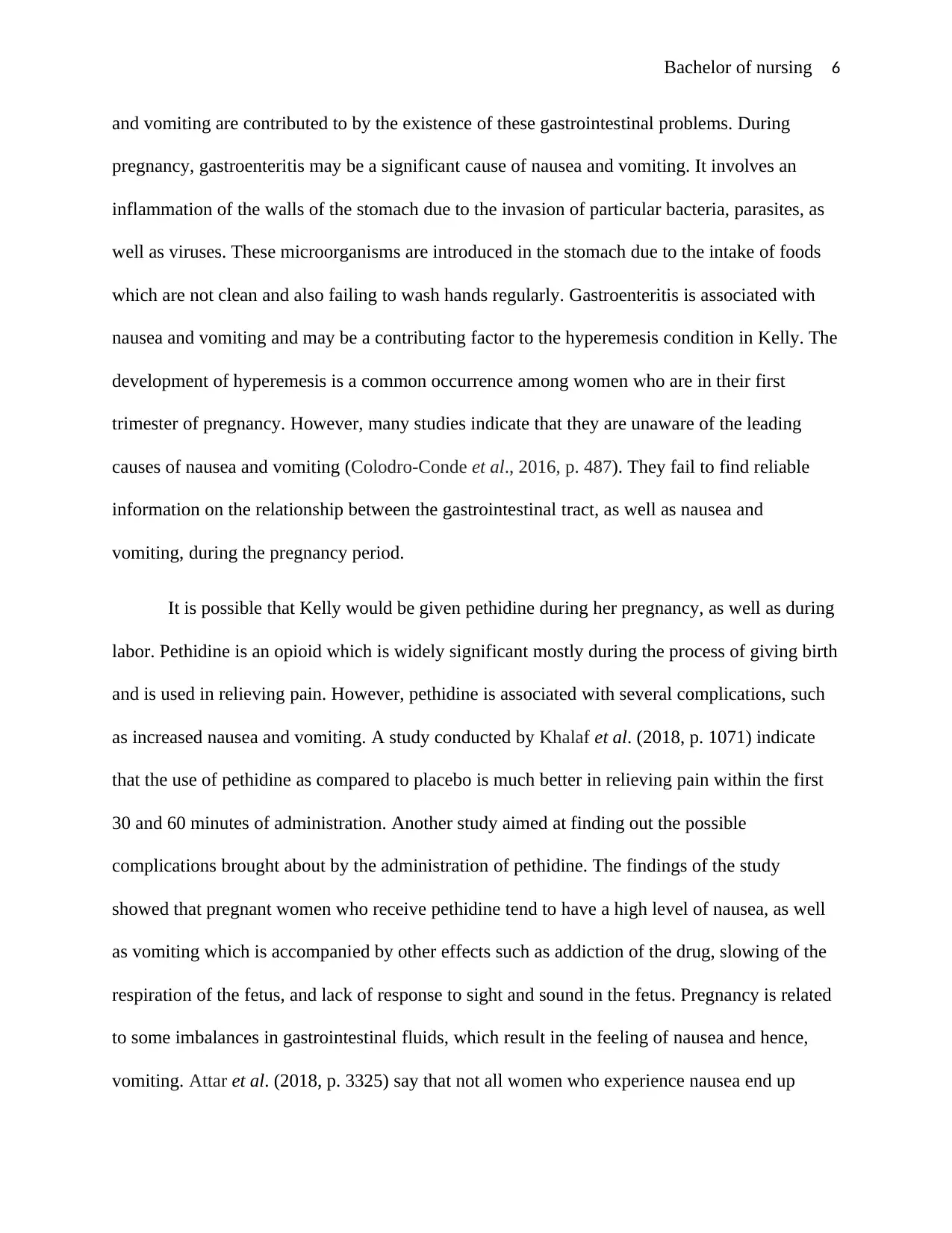
Bachelor of nursing 6
and vomiting are contributed to by the existence of these gastrointestinal problems. During
pregnancy, gastroenteritis may be a significant cause of nausea and vomiting. It involves an
inflammation of the walls of the stomach due to the invasion of particular bacteria, parasites, as
well as viruses. These microorganisms are introduced in the stomach due to the intake of foods
which are not clean and also failing to wash hands regularly. Gastroenteritis is associated with
nausea and vomiting and may be a contributing factor to the hyperemesis condition in Kelly. The
development of hyperemesis is a common occurrence among women who are in their first
trimester of pregnancy. However, many studies indicate that they are unaware of the leading
causes of nausea and vomiting (Colodro-Conde et al., 2016, p. 487). They fail to find reliable
information on the relationship between the gastrointestinal tract, as well as nausea and
vomiting, during the pregnancy period.
It is possible that Kelly would be given pethidine during her pregnancy, as well as during
labor. Pethidine is an opioid which is widely significant mostly during the process of giving birth
and is used in relieving pain. However, pethidine is associated with several complications, such
as increased nausea and vomiting. A study conducted by Khalaf et al. (2018, p. 1071) indicate
that the use of pethidine as compared to placebo is much better in relieving pain within the first
30 and 60 minutes of administration. Another study aimed at finding out the possible
complications brought about by the administration of pethidine. The findings of the study
showed that pregnant women who receive pethidine tend to have a high level of nausea, as well
as vomiting which is accompanied by other effects such as addiction of the drug, slowing of the
respiration of the fetus, and lack of response to sight and sound in the fetus. Pregnancy is related
to some imbalances in gastrointestinal fluids, which result in the feeling of nausea and hence,
vomiting. Attar et al. (2018, p. 3325) say that not all women who experience nausea end up
and vomiting are contributed to by the existence of these gastrointestinal problems. During
pregnancy, gastroenteritis may be a significant cause of nausea and vomiting. It involves an
inflammation of the walls of the stomach due to the invasion of particular bacteria, parasites, as
well as viruses. These microorganisms are introduced in the stomach due to the intake of foods
which are not clean and also failing to wash hands regularly. Gastroenteritis is associated with
nausea and vomiting and may be a contributing factor to the hyperemesis condition in Kelly. The
development of hyperemesis is a common occurrence among women who are in their first
trimester of pregnancy. However, many studies indicate that they are unaware of the leading
causes of nausea and vomiting (Colodro-Conde et al., 2016, p. 487). They fail to find reliable
information on the relationship between the gastrointestinal tract, as well as nausea and
vomiting, during the pregnancy period.
It is possible that Kelly would be given pethidine during her pregnancy, as well as during
labor. Pethidine is an opioid which is widely significant mostly during the process of giving birth
and is used in relieving pain. However, pethidine is associated with several complications, such
as increased nausea and vomiting. A study conducted by Khalaf et al. (2018, p. 1071) indicate
that the use of pethidine as compared to placebo is much better in relieving pain within the first
30 and 60 minutes of administration. Another study aimed at finding out the possible
complications brought about by the administration of pethidine. The findings of the study
showed that pregnant women who receive pethidine tend to have a high level of nausea, as well
as vomiting which is accompanied by other effects such as addiction of the drug, slowing of the
respiration of the fetus, and lack of response to sight and sound in the fetus. Pregnancy is related
to some imbalances in gastrointestinal fluids, which result in the feeling of nausea and hence,
vomiting. Attar et al. (2018, p. 3325) say that not all women who experience nausea end up
⊘ This is a preview!⊘
Do you want full access?
Subscribe today to unlock all pages.

Trusted by 1+ million students worldwide
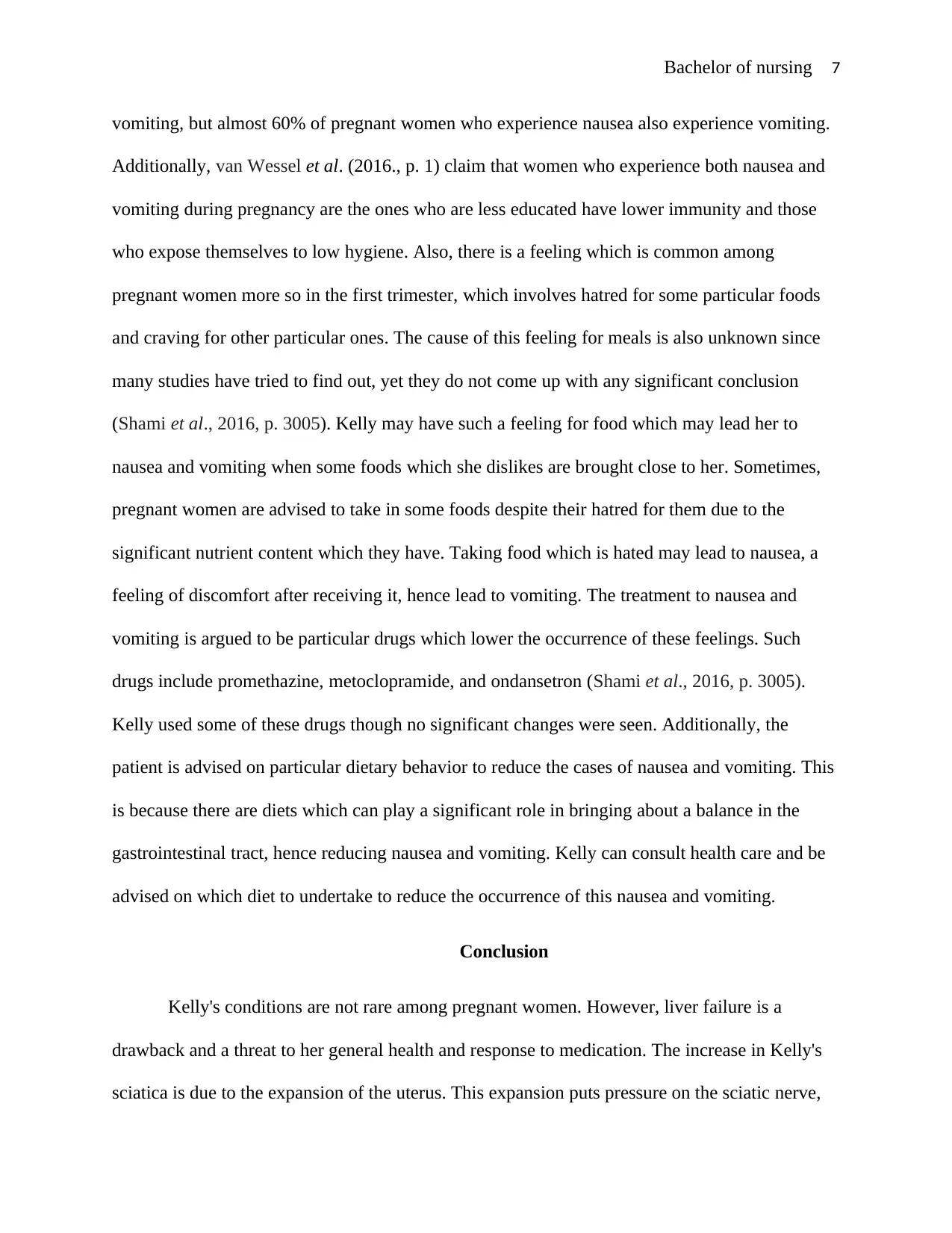
Bachelor of nursing 7
vomiting, but almost 60% of pregnant women who experience nausea also experience vomiting.
Additionally, van Wessel et al. (2016., p. 1) claim that women who experience both nausea and
vomiting during pregnancy are the ones who are less educated have lower immunity and those
who expose themselves to low hygiene. Also, there is a feeling which is common among
pregnant women more so in the first trimester, which involves hatred for some particular foods
and craving for other particular ones. The cause of this feeling for meals is also unknown since
many studies have tried to find out, yet they do not come up with any significant conclusion
(Shami et al., 2016, p. 3005). Kelly may have such a feeling for food which may lead her to
nausea and vomiting when some foods which she dislikes are brought close to her. Sometimes,
pregnant women are advised to take in some foods despite their hatred for them due to the
significant nutrient content which they have. Taking food which is hated may lead to nausea, a
feeling of discomfort after receiving it, hence lead to vomiting. The treatment to nausea and
vomiting is argued to be particular drugs which lower the occurrence of these feelings. Such
drugs include promethazine, metoclopramide, and ondansetron (Shami et al., 2016, p. 3005).
Kelly used some of these drugs though no significant changes were seen. Additionally, the
patient is advised on particular dietary behavior to reduce the cases of nausea and vomiting. This
is because there are diets which can play a significant role in bringing about a balance in the
gastrointestinal tract, hence reducing nausea and vomiting. Kelly can consult health care and be
advised on which diet to undertake to reduce the occurrence of this nausea and vomiting.
Conclusion
Kelly's conditions are not rare among pregnant women. However, liver failure is a
drawback and a threat to her general health and response to medication. The increase in Kelly's
sciatica is due to the expansion of the uterus. This expansion puts pressure on the sciatic nerve,
vomiting, but almost 60% of pregnant women who experience nausea also experience vomiting.
Additionally, van Wessel et al. (2016., p. 1) claim that women who experience both nausea and
vomiting during pregnancy are the ones who are less educated have lower immunity and those
who expose themselves to low hygiene. Also, there is a feeling which is common among
pregnant women more so in the first trimester, which involves hatred for some particular foods
and craving for other particular ones. The cause of this feeling for meals is also unknown since
many studies have tried to find out, yet they do not come up with any significant conclusion
(Shami et al., 2016, p. 3005). Kelly may have such a feeling for food which may lead her to
nausea and vomiting when some foods which she dislikes are brought close to her. Sometimes,
pregnant women are advised to take in some foods despite their hatred for them due to the
significant nutrient content which they have. Taking food which is hated may lead to nausea, a
feeling of discomfort after receiving it, hence lead to vomiting. The treatment to nausea and
vomiting is argued to be particular drugs which lower the occurrence of these feelings. Such
drugs include promethazine, metoclopramide, and ondansetron (Shami et al., 2016, p. 3005).
Kelly used some of these drugs though no significant changes were seen. Additionally, the
patient is advised on particular dietary behavior to reduce the cases of nausea and vomiting. This
is because there are diets which can play a significant role in bringing about a balance in the
gastrointestinal tract, hence reducing nausea and vomiting. Kelly can consult health care and be
advised on which diet to undertake to reduce the occurrence of this nausea and vomiting.
Conclusion
Kelly's conditions are not rare among pregnant women. However, liver failure is a
drawback and a threat to her general health and response to medication. The increase in Kelly's
sciatica is due to the expansion of the uterus. This expansion puts pressure on the sciatic nerve,
Paraphrase This Document
Need a fresh take? Get an instant paraphrase of this document with our AI Paraphraser
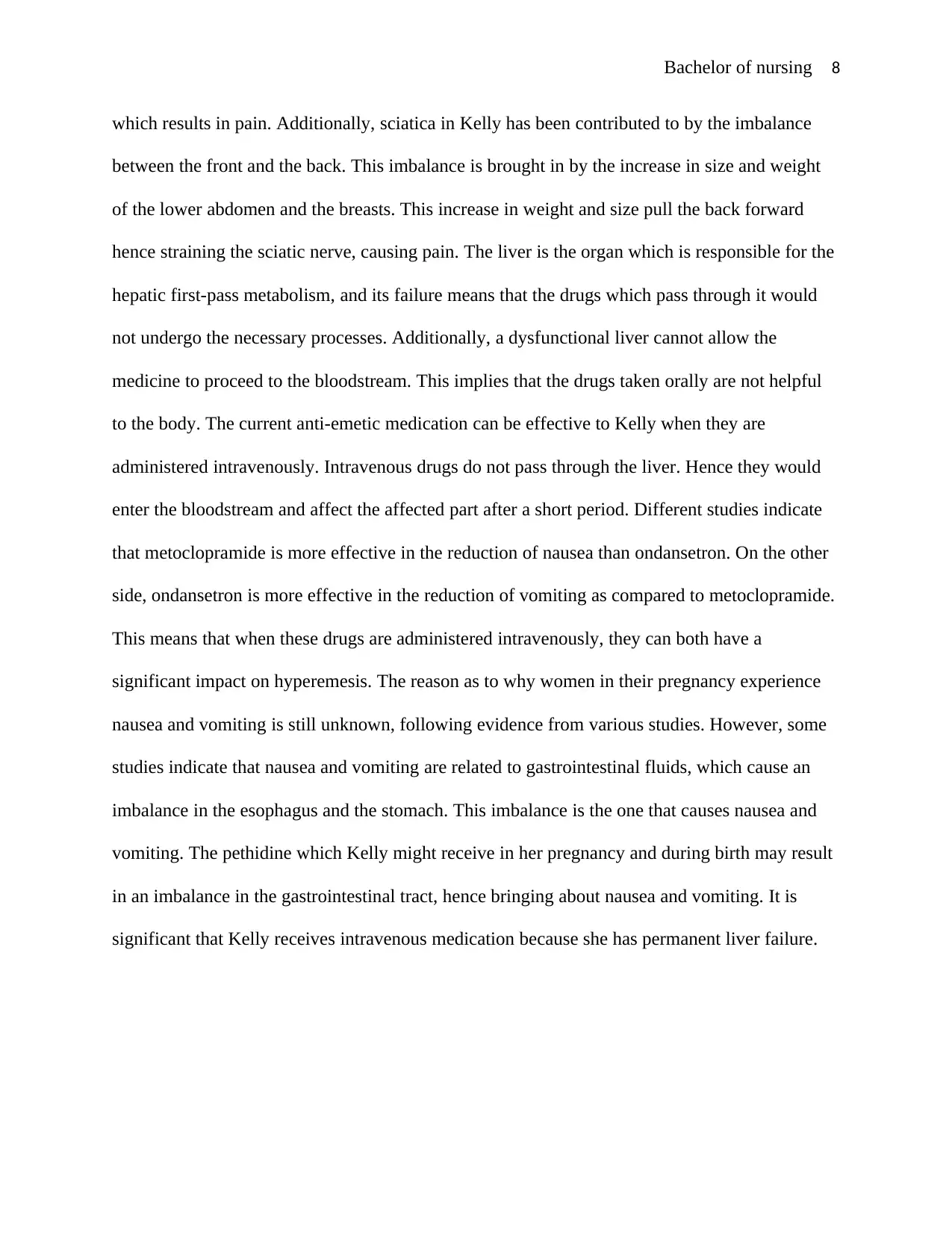
Bachelor of nursing 8
which results in pain. Additionally, sciatica in Kelly has been contributed to by the imbalance
between the front and the back. This imbalance is brought in by the increase in size and weight
of the lower abdomen and the breasts. This increase in weight and size pull the back forward
hence straining the sciatic nerve, causing pain. The liver is the organ which is responsible for the
hepatic first-pass metabolism, and its failure means that the drugs which pass through it would
not undergo the necessary processes. Additionally, a dysfunctional liver cannot allow the
medicine to proceed to the bloodstream. This implies that the drugs taken orally are not helpful
to the body. The current anti-emetic medication can be effective to Kelly when they are
administered intravenously. Intravenous drugs do not pass through the liver. Hence they would
enter the bloodstream and affect the affected part after a short period. Different studies indicate
that metoclopramide is more effective in the reduction of nausea than ondansetron. On the other
side, ondansetron is more effective in the reduction of vomiting as compared to metoclopramide.
This means that when these drugs are administered intravenously, they can both have a
significant impact on hyperemesis. The reason as to why women in their pregnancy experience
nausea and vomiting is still unknown, following evidence from various studies. However, some
studies indicate that nausea and vomiting are related to gastrointestinal fluids, which cause an
imbalance in the esophagus and the stomach. This imbalance is the one that causes nausea and
vomiting. The pethidine which Kelly might receive in her pregnancy and during birth may result
in an imbalance in the gastrointestinal tract, hence bringing about nausea and vomiting. It is
significant that Kelly receives intravenous medication because she has permanent liver failure.
which results in pain. Additionally, sciatica in Kelly has been contributed to by the imbalance
between the front and the back. This imbalance is brought in by the increase in size and weight
of the lower abdomen and the breasts. This increase in weight and size pull the back forward
hence straining the sciatic nerve, causing pain. The liver is the organ which is responsible for the
hepatic first-pass metabolism, and its failure means that the drugs which pass through it would
not undergo the necessary processes. Additionally, a dysfunctional liver cannot allow the
medicine to proceed to the bloodstream. This implies that the drugs taken orally are not helpful
to the body. The current anti-emetic medication can be effective to Kelly when they are
administered intravenously. Intravenous drugs do not pass through the liver. Hence they would
enter the bloodstream and affect the affected part after a short period. Different studies indicate
that metoclopramide is more effective in the reduction of nausea than ondansetron. On the other
side, ondansetron is more effective in the reduction of vomiting as compared to metoclopramide.
This means that when these drugs are administered intravenously, they can both have a
significant impact on hyperemesis. The reason as to why women in their pregnancy experience
nausea and vomiting is still unknown, following evidence from various studies. However, some
studies indicate that nausea and vomiting are related to gastrointestinal fluids, which cause an
imbalance in the esophagus and the stomach. This imbalance is the one that causes nausea and
vomiting. The pethidine which Kelly might receive in her pregnancy and during birth may result
in an imbalance in the gastrointestinal tract, hence bringing about nausea and vomiting. It is
significant that Kelly receives intravenous medication because she has permanent liver failure.
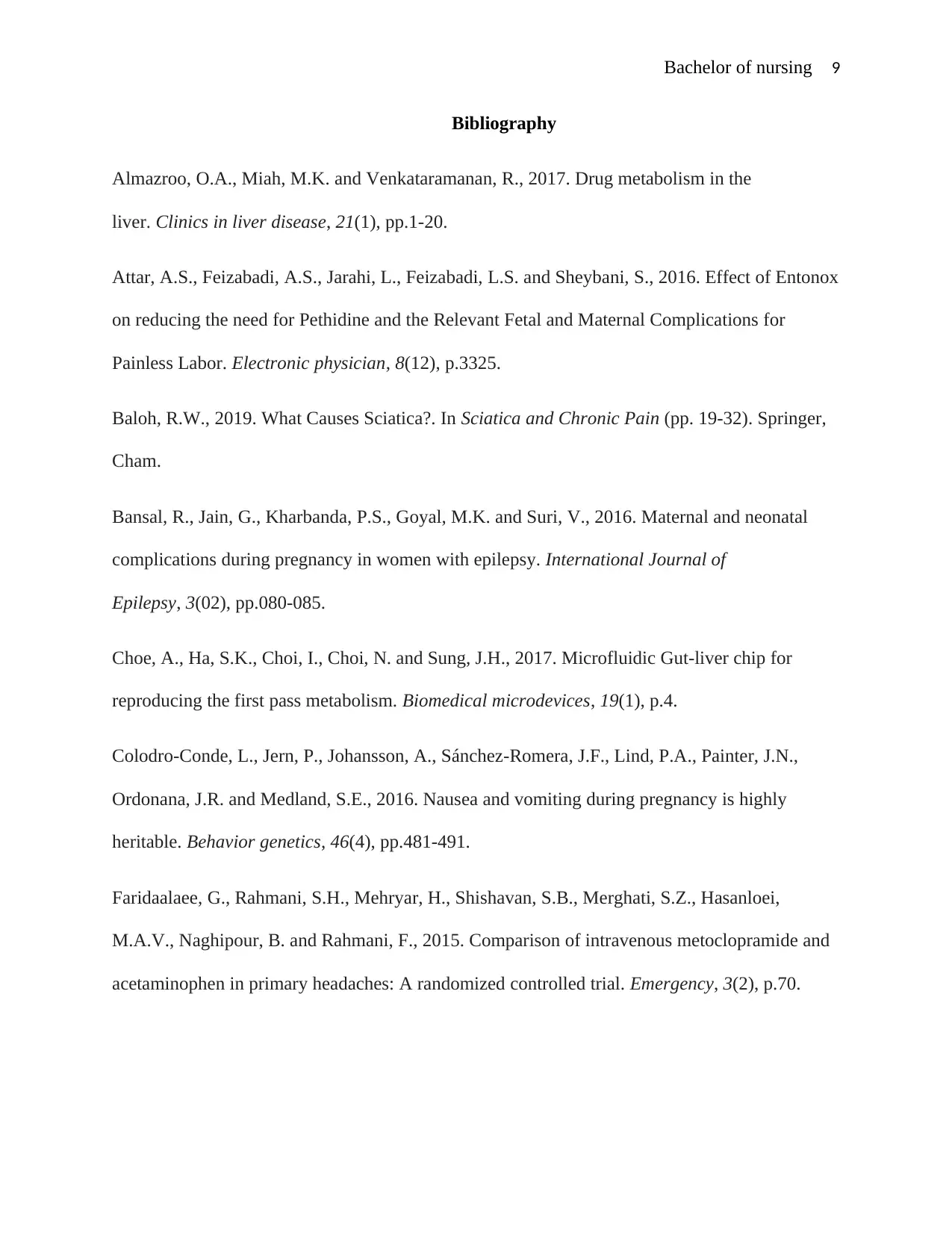
Bachelor of nursing 9
Bibliography
Almazroo, O.A., Miah, M.K. and Venkataramanan, R., 2017. Drug metabolism in the
liver. Clinics in liver disease, 21(1), pp.1-20.
Attar, A.S., Feizabadi, A.S., Jarahi, L., Feizabadi, L.S. and Sheybani, S., 2016. Effect of Entonox
on reducing the need for Pethidine and the Relevant Fetal and Maternal Complications for
Painless Labor. Electronic physician, 8(12), p.3325.
Baloh, R.W., 2019. What Causes Sciatica?. In Sciatica and Chronic Pain (pp. 19-32). Springer,
Cham.
Bansal, R., Jain, G., Kharbanda, P.S., Goyal, M.K. and Suri, V., 2016. Maternal and neonatal
complications during pregnancy in women with epilepsy. International Journal of
Epilepsy, 3(02), pp.080-085.
Choe, A., Ha, S.K., Choi, I., Choi, N. and Sung, J.H., 2017. Microfluidic Gut-liver chip for
reproducing the first pass metabolism. Biomedical microdevices, 19(1), p.4.
Colodro-Conde, L., Jern, P., Johansson, A., Sánchez-Romera, J.F., Lind, P.A., Painter, J.N.,
Ordonana, J.R. and Medland, S.E., 2016. Nausea and vomiting during pregnancy is highly
heritable. Behavior genetics, 46(4), pp.481-491.
Faridaalaee, G., Rahmani, S.H., Mehryar, H., Shishavan, S.B., Merghati, S.Z., Hasanloei,
M.A.V., Naghipour, B. and Rahmani, F., 2015. Comparison of intravenous metoclopramide and
acetaminophen in primary headaches: A randomized controlled trial. Emergency, 3(2), p.70.
Bibliography
Almazroo, O.A., Miah, M.K. and Venkataramanan, R., 2017. Drug metabolism in the
liver. Clinics in liver disease, 21(1), pp.1-20.
Attar, A.S., Feizabadi, A.S., Jarahi, L., Feizabadi, L.S. and Sheybani, S., 2016. Effect of Entonox
on reducing the need for Pethidine and the Relevant Fetal and Maternal Complications for
Painless Labor. Electronic physician, 8(12), p.3325.
Baloh, R.W., 2019. What Causes Sciatica?. In Sciatica and Chronic Pain (pp. 19-32). Springer,
Cham.
Bansal, R., Jain, G., Kharbanda, P.S., Goyal, M.K. and Suri, V., 2016. Maternal and neonatal
complications during pregnancy in women with epilepsy. International Journal of
Epilepsy, 3(02), pp.080-085.
Choe, A., Ha, S.K., Choi, I., Choi, N. and Sung, J.H., 2017. Microfluidic Gut-liver chip for
reproducing the first pass metabolism. Biomedical microdevices, 19(1), p.4.
Colodro-Conde, L., Jern, P., Johansson, A., Sánchez-Romera, J.F., Lind, P.A., Painter, J.N.,
Ordonana, J.R. and Medland, S.E., 2016. Nausea and vomiting during pregnancy is highly
heritable. Behavior genetics, 46(4), pp.481-491.
Faridaalaee, G., Rahmani, S.H., Mehryar, H., Shishavan, S.B., Merghati, S.Z., Hasanloei,
M.A.V., Naghipour, B. and Rahmani, F., 2015. Comparison of intravenous metoclopramide and
acetaminophen in primary headaches: A randomized controlled trial. Emergency, 3(2), p.70.
⊘ This is a preview!⊘
Do you want full access?
Subscribe today to unlock all pages.

Trusted by 1+ million students worldwide
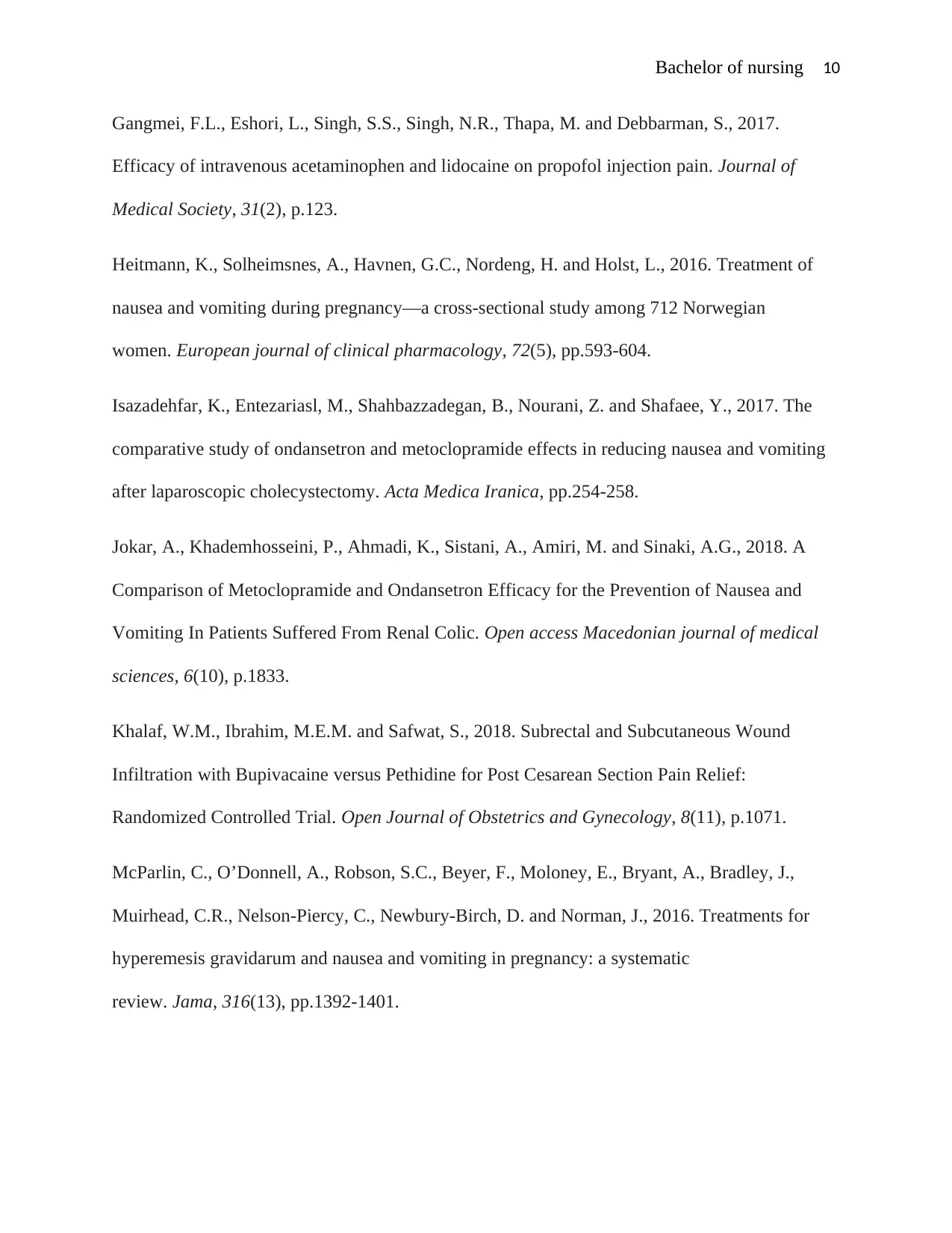
Bachelor of nursing 10
Gangmei, F.L., Eshori, L., Singh, S.S., Singh, N.R., Thapa, M. and Debbarman, S., 2017.
Efficacy of intravenous acetaminophen and lidocaine on propofol injection pain. Journal of
Medical Society, 31(2), p.123.
Heitmann, K., Solheimsnes, A., Havnen, G.C., Nordeng, H. and Holst, L., 2016. Treatment of
nausea and vomiting during pregnancy—a cross-sectional study among 712 Norwegian
women. European journal of clinical pharmacology, 72(5), pp.593-604.
Isazadehfar, K., Entezariasl, M., Shahbazzadegan, B., Nourani, Z. and Shafaee, Y., 2017. The
comparative study of ondansetron and metoclopramide effects in reducing nausea and vomiting
after laparoscopic cholecystectomy. Acta Medica Iranica, pp.254-258.
Jokar, A., Khademhosseini, P., Ahmadi, K., Sistani, A., Amiri, M. and Sinaki, A.G., 2018. A
Comparison of Metoclopramide and Ondansetron Efficacy for the Prevention of Nausea and
Vomiting In Patients Suffered From Renal Colic. Open access Macedonian journal of medical
sciences, 6(10), p.1833.
Khalaf, W.M., Ibrahim, M.E.M. and Safwat, S., 2018. Subrectal and Subcutaneous Wound
Infiltration with Bupivacaine versus Pethidine for Post Cesarean Section Pain Relief:
Randomized Controlled Trial. Open Journal of Obstetrics and Gynecology, 8(11), p.1071.
McParlin, C., O’Donnell, A., Robson, S.C., Beyer, F., Moloney, E., Bryant, A., Bradley, J.,
Muirhead, C.R., Nelson-Piercy, C., Newbury-Birch, D. and Norman, J., 2016. Treatments for
hyperemesis gravidarum and nausea and vomiting in pregnancy: a systematic
review. Jama, 316(13), pp.1392-1401.
Gangmei, F.L., Eshori, L., Singh, S.S., Singh, N.R., Thapa, M. and Debbarman, S., 2017.
Efficacy of intravenous acetaminophen and lidocaine on propofol injection pain. Journal of
Medical Society, 31(2), p.123.
Heitmann, K., Solheimsnes, A., Havnen, G.C., Nordeng, H. and Holst, L., 2016. Treatment of
nausea and vomiting during pregnancy—a cross-sectional study among 712 Norwegian
women. European journal of clinical pharmacology, 72(5), pp.593-604.
Isazadehfar, K., Entezariasl, M., Shahbazzadegan, B., Nourani, Z. and Shafaee, Y., 2017. The
comparative study of ondansetron and metoclopramide effects in reducing nausea and vomiting
after laparoscopic cholecystectomy. Acta Medica Iranica, pp.254-258.
Jokar, A., Khademhosseini, P., Ahmadi, K., Sistani, A., Amiri, M. and Sinaki, A.G., 2018. A
Comparison of Metoclopramide and Ondansetron Efficacy for the Prevention of Nausea and
Vomiting In Patients Suffered From Renal Colic. Open access Macedonian journal of medical
sciences, 6(10), p.1833.
Khalaf, W.M., Ibrahim, M.E.M. and Safwat, S., 2018. Subrectal and Subcutaneous Wound
Infiltration with Bupivacaine versus Pethidine for Post Cesarean Section Pain Relief:
Randomized Controlled Trial. Open Journal of Obstetrics and Gynecology, 8(11), p.1071.
McParlin, C., O’Donnell, A., Robson, S.C., Beyer, F., Moloney, E., Bryant, A., Bradley, J.,
Muirhead, C.R., Nelson-Piercy, C., Newbury-Birch, D. and Norman, J., 2016. Treatments for
hyperemesis gravidarum and nausea and vomiting in pregnancy: a systematic
review. Jama, 316(13), pp.1392-1401.
Paraphrase This Document
Need a fresh take? Get an instant paraphrase of this document with our AI Paraphraser
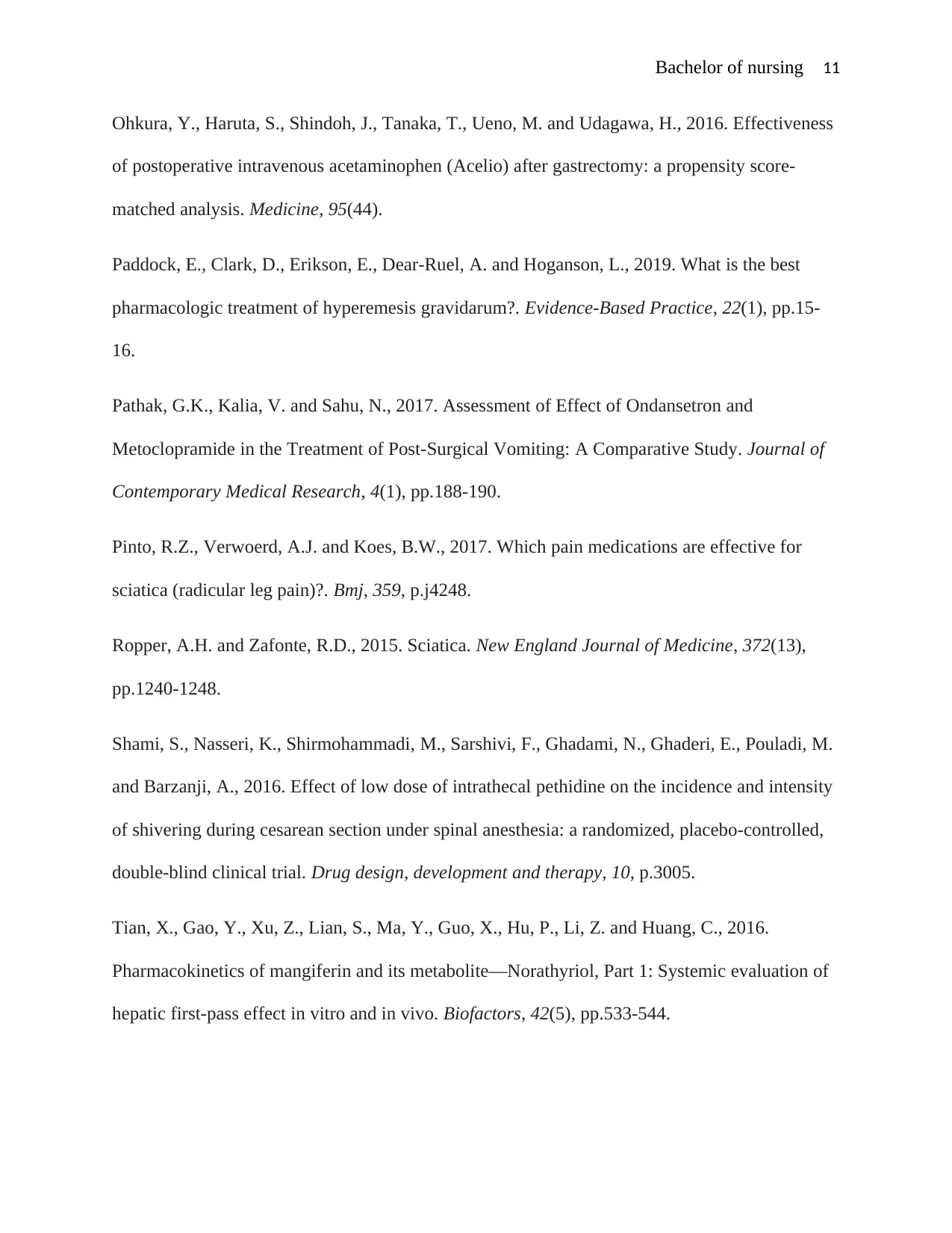
Bachelor of nursing 11
Ohkura, Y., Haruta, S., Shindoh, J., Tanaka, T., Ueno, M. and Udagawa, H., 2016. Effectiveness
of postoperative intravenous acetaminophen (Acelio) after gastrectomy: a propensity score-
matched analysis. Medicine, 95(44).
Paddock, E., Clark, D., Erikson, E., Dear-Ruel, A. and Hoganson, L., 2019. What is the best
pharmacologic treatment of hyperemesis gravidarum?. Evidence-Based Practice, 22(1), pp.15-
16.
Pathak, G.K., Kalia, V. and Sahu, N., 2017. Assessment of Effect of Ondansetron and
Metoclopramide in the Treatment of Post-Surgical Vomiting: A Comparative Study. Journal of
Contemporary Medical Research, 4(1), pp.188-190.
Pinto, R.Z., Verwoerd, A.J. and Koes, B.W., 2017. Which pain medications are effective for
sciatica (radicular leg pain)?. Bmj, 359, p.j4248.
Ropper, A.H. and Zafonte, R.D., 2015. Sciatica. New England Journal of Medicine, 372(13),
pp.1240-1248.
Shami, S., Nasseri, K., Shirmohammadi, M., Sarshivi, F., Ghadami, N., Ghaderi, E., Pouladi, M.
and Barzanji, A., 2016. Effect of low dose of intrathecal pethidine on the incidence and intensity
of shivering during cesarean section under spinal anesthesia: a randomized, placebo-controlled,
double-blind clinical trial. Drug design, development and therapy, 10, p.3005.
Tian, X., Gao, Y., Xu, Z., Lian, S., Ma, Y., Guo, X., Hu, P., Li, Z. and Huang, C., 2016.
Pharmacokinetics of mangiferin and its metabolite—Norathyriol, Part 1: Systemic evaluation of
hepatic first‐pass effect in vitro and in vivo. Biofactors, 42(5), pp.533-544.
Ohkura, Y., Haruta, S., Shindoh, J., Tanaka, T., Ueno, M. and Udagawa, H., 2016. Effectiveness
of postoperative intravenous acetaminophen (Acelio) after gastrectomy: a propensity score-
matched analysis. Medicine, 95(44).
Paddock, E., Clark, D., Erikson, E., Dear-Ruel, A. and Hoganson, L., 2019. What is the best
pharmacologic treatment of hyperemesis gravidarum?. Evidence-Based Practice, 22(1), pp.15-
16.
Pathak, G.K., Kalia, V. and Sahu, N., 2017. Assessment of Effect of Ondansetron and
Metoclopramide in the Treatment of Post-Surgical Vomiting: A Comparative Study. Journal of
Contemporary Medical Research, 4(1), pp.188-190.
Pinto, R.Z., Verwoerd, A.J. and Koes, B.W., 2017. Which pain medications are effective for
sciatica (radicular leg pain)?. Bmj, 359, p.j4248.
Ropper, A.H. and Zafonte, R.D., 2015. Sciatica. New England Journal of Medicine, 372(13),
pp.1240-1248.
Shami, S., Nasseri, K., Shirmohammadi, M., Sarshivi, F., Ghadami, N., Ghaderi, E., Pouladi, M.
and Barzanji, A., 2016. Effect of low dose of intrathecal pethidine on the incidence and intensity
of shivering during cesarean section under spinal anesthesia: a randomized, placebo-controlled,
double-blind clinical trial. Drug design, development and therapy, 10, p.3005.
Tian, X., Gao, Y., Xu, Z., Lian, S., Ma, Y., Guo, X., Hu, P., Li, Z. and Huang, C., 2016.
Pharmacokinetics of mangiferin and its metabolite—Norathyriol, Part 1: Systemic evaluation of
hepatic first‐pass effect in vitro and in vivo. Biofactors, 42(5), pp.533-544.
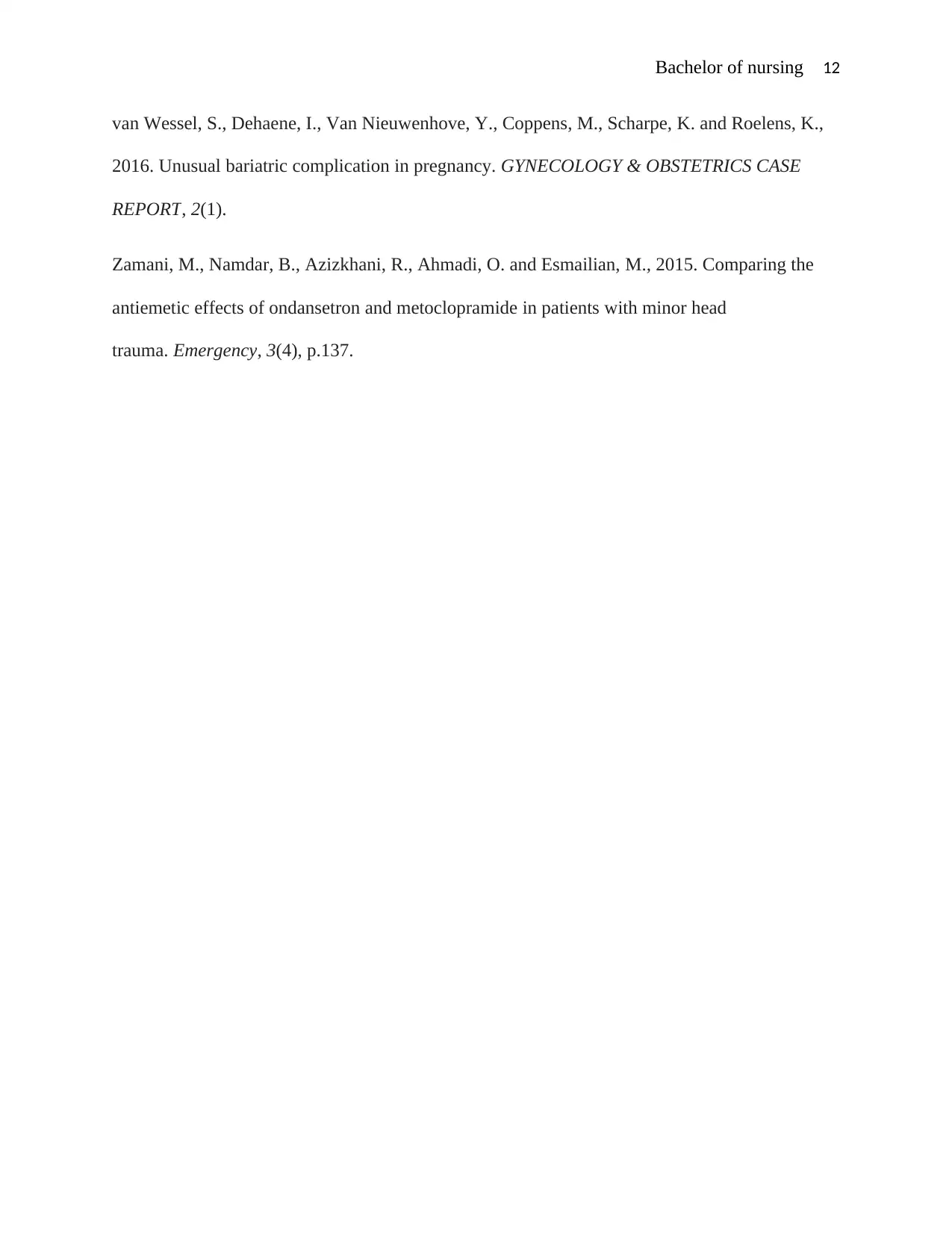
Bachelor of nursing 12
van Wessel, S., Dehaene, I., Van Nieuwenhove, Y., Coppens, M., Scharpe, K. and Roelens, K.,
2016. Unusual bariatric complication in pregnancy. GYNECOLOGY & OBSTETRICS CASE
REPORT, 2(1).
Zamani, M., Namdar, B., Azizkhani, R., Ahmadi, O. and Esmailian, M., 2015. Comparing the
antiemetic effects of ondansetron and metoclopramide in patients with minor head
trauma. Emergency, 3(4), p.137.
van Wessel, S., Dehaene, I., Van Nieuwenhove, Y., Coppens, M., Scharpe, K. and Roelens, K.,
2016. Unusual bariatric complication in pregnancy. GYNECOLOGY & OBSTETRICS CASE
REPORT, 2(1).
Zamani, M., Namdar, B., Azizkhani, R., Ahmadi, O. and Esmailian, M., 2015. Comparing the
antiemetic effects of ondansetron and metoclopramide in patients with minor head
trauma. Emergency, 3(4), p.137.
⊘ This is a preview!⊘
Do you want full access?
Subscribe today to unlock all pages.

Trusted by 1+ million students worldwide
1 out of 12
Related Documents
Your All-in-One AI-Powered Toolkit for Academic Success.
+13062052269
info@desklib.com
Available 24*7 on WhatsApp / Email
![[object Object]](/_next/static/media/star-bottom.7253800d.svg)
Unlock your academic potential
Copyright © 2020–2025 A2Z Services. All Rights Reserved. Developed and managed by ZUCOL.



